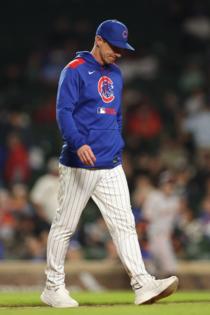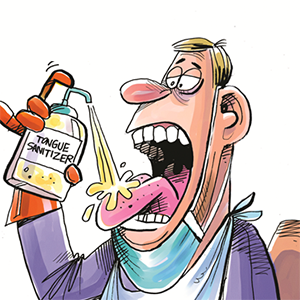Paul Sullivan: Cubs' rotation outlook is hazy -- just like the skies at Wrigley Field in Friday's loss
Published in Baseball
CHICAGO — The Chicago Cubs’ rotation will be under the microscope at least until Shota Imanaga returns from his left hamstring strain, which could be sometime in June if his rehab goes according to plan.
In the meantime, they’ll try to get by with Jameson Taillon and four starters who came into the season as question marks due to past injuries, inconsistency or inexperience.
Colin Rea, Matt Boyd, Ben Brown and rookie Cade Horton have collectively filled the void so far, as evidenced by the Cubs’ 14-8 record since Imanaga’s injury.
But some bumps in the road are to be expected, and Friday was one of those days for Rea, who turned in a subpar performance in a 6-2 loss to the Cincinnati Reds before 36,019 at Wrigley Field.
After the game, the Cubs announced left-handed reliever Drew Pomeranz would start Saturday’s game, the second time manager Craig Counsell will employ an opener this season. The right-handed Brown is expected to follow Pomeranz.
The Cubs looked dazed and confused Friday against Reds starter Andrew Abbott, who held them scoreless and to one hit in a seven-inning outing. A late rally in the eighth fizzled out, and they stranded four baserunners in the final two innings.
“We didn’t swing the bats too great, but a lot of that is in part due to (Abbott) today,” Dansby Swanson said.
So the Cubs saw their win streak snapped at four under a hazy sky due to the Canadian wildfires, as Rea served up three home runs in 5 2/3 innings, including one to TJ Friedl leading off the game.
Rea allowed six runs on 10 hits in his second straight shellacking by the Reds. His ERA rose from 2.38 to 3.96 after those two losses.
After last Sunday’s comeback against the Reds bullpen in an 11-8 win, the crowd appeared ready for a rerun Friday when they broke through in the eighth. But Kyle Tucker grounded into an inning-ending double play with two men on, and Swanson and Nico Hoerner failed to deliver against Emilio Pagán with two on in the ninth.
And now for something completely different — the Cubs will use an opener again, as Counsell searches for a way to fix Brown’s first-inning woes.
“The best way to win the game we think is to consider an opener (Saturday), depending on who is available,” Counsell said before the game. “We’ll look at that. That’s kind of how the decision gets made. There are things Ben can do better. When you use an opener for a starter, you’re trying to get a better solution for the first innings and probably get a better solution as you get to the back end of the appearance.”
Brown has posted a 9.90 ERA in his first innings, and gave up runs in the opening frame of three of his last four starts, including four against the Reds last Sunday in Cincinnati. He has the stuff, but can often be his own worst enemy.
“The last two (games), and three of my four rough outings this year, have been like the first inning,” the 25-year-old Brown said. “Not being locked in, whether mentally or physically … that really sets me up for failure later in the game.
“I don’t necessarily think it’s like a problem with the third time through the order, because I’ve done it plenty of times where I’ve done really good things as the game has progressed.”
Brown said he’s worked on things to “tone down the intensity” of his first innings. In his last start, he walked the first two Reds batters in a four-run inning before settling down, then gave up four more runs in the fifth. Counsell said Friday that Brown “gave away the first 10 pitches of the game, essentially.” It proved costly, though the Cubs came back from an 8-3 deficit in that 11-8 win.
Counsell said the hardest innings for starters are typically the first and the sixth or seventh, meaning their last one.
“We tend to examine routine a little bit when you struggle with it,” he said of Brown. “Frankly, it’s an easier way to make some tweaks than maybe adding a change-up, right? A little easier to think about some adjustments there. So it’s a place we can spend some time with some focus and just do something different, because it warrants doing something different.”
Counsell said Brown is not in danger of losing his starting spot. He didn’t rule out using an opener for Brown again, but added he could do that for any other starter. Counsell used an opener for Cade Horton in his major league debut on May 10 against the New York Mets, trying to alleviate the pressure on the rookie by using reliever Brad Keller to face Mets sluggers Francisco Lindor, Juan Soto and Pete Alonso. It worked out well for Horton and the Cubs in a 6-5 win at Citi Field.
Managers have been looking for solutions to pitchers’ problems forever, with varying degrees of success. Once in a while, they turn to unconventional methods to solve age-old issues. Some ideas work. Some are best forgotten.
Back in July 1995, former White Sox manager Terry Bevington announced a plan to fix a recurring issue in which Sox starters issued too many walks and frequently watched them come around to score.
“I know for a fact that the starters will not allow more than two walks to score,” Bevington declared after one such game. “I know that for a fact. It will never happen again. Guarantee it.”
Guarantee it? How so?
“They walk two guys (and) they score, they’re coming out of the game,” he said. “I’ve seen enough.”
The automatic hook was called “the ‘Bev’ rule,” and became a running joke in the Sox press box. But it never came to fruition after veteran starter Jim Abbott told the media the Bev rule would put undue pressure on the starters. Bevington chickened out, and Abbott, perhaps not coincidentally, was traded to the California Angels a couple weeks later.
Counsell’s idea is more conventional, and unlike Bevington, he’s a well-respected manager with a history of success. Using an opener has been a much-copied strategy in baseball since Tampa Bay manager Kevin Cash began using them frequently in 2018.
The opener for Saturday could be a one-time thing to help Brown focus. Or it could be the start of a new trend. Either way, Counsell is not afraid to try something different if he believes it can help lead to a Cubs win, and Brown has already bought into the idea.
“Without putting too much pressure on (myself) when I go out there my first inning of pitching, I’m not going to be in panic mode,” Brown said. “And that’s step one.”
The plan is in place.
Now it’s up to the Cubs to make it work.
©2025 Chicago Tribune. Visit chicagotribune.com. Distributed by Tribune Content Agency, LLC.







Comments